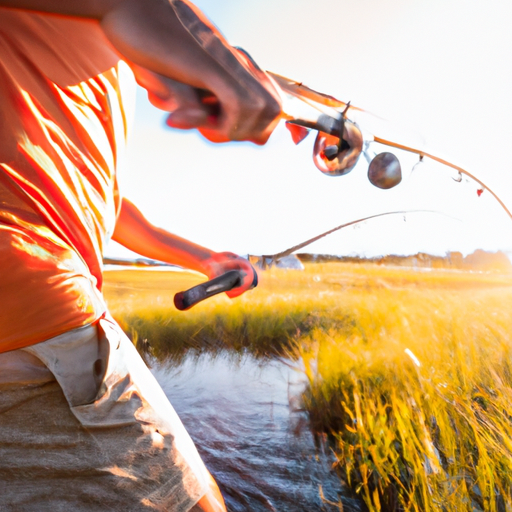Are you an avid fisherman searching for the perfect fishing rod guide? Look no further! Whether you’re a seasoned angler or just starting out, choosing the right fishing rod guide is crucial for a successful fishing experience. With so many options available, it can be overwhelming to make the right choice. But fret not! This comprehensive guide will walk you through the factors to consider when selecting a fishing rod guide and provide you with expert recommendations to help you find the perfect fit for your fishing needs. So, grab your gear and get ready to reel in the big one with confidence!

Types of Fishing Rod Guides
Spinning Guides
Spinning guides are specifically designed for spinning reels, which are commonly used in freshwater and light saltwater fishing. These guides are characterized by their large inner diameter, which allows the fishing line to pass through more easily. They typically have a small opening at the tip to prevent the line from getting tangled. Spinning guides are commonly made of materials like ceramic, stainless steel, or aluminum oxide.
Casting Guides
Casting guides, also known as conventional guides, are used with casting reels. These guides are designed to handle the increased tension and friction that occurs when using baitcasting or conventional reels. They have a smaller inner diameter compared to spinning guides and are usually made of materials like ceramic, stainless steel, or titanium. The smaller opening at the tip helps control the line for accurate casting.
Fly Guides
Fly guides, as the name suggests, are designed for fly fishing rods. These guides are typically much larger in diameter compared to their spinning or casting counterparts. They are designed to allow the smooth passage of the fly line, which is heavier and thicker than traditional fishing lines. Fly guides commonly feature a larger, flared opening at the tip to prevent the line from getting stuck.
Ice Guides
Ice fishing requires specialized equipment, including ice fishing rods with unique guides. Ice guides are designed to be compact and lightweight, designed to fit on short ice fishing rods. These guides are typically made of materials like stainless steel or ceramic, as they need to withstand extremely cold temperatures. Ice guides often feature a smaller inner diameter to accommodate thinner ice fishing lines.
Surf Guides
Surf fishing rods require guides that can handle the challenges of casting in the ocean. Surf guides are designed to be large and sturdy to handle the heavier lines used in saltwater fishing. They are commonly made of materials like stainless steel or titanium to withstand the corrosive effects of saltwater. These guides often have a larger opening at the tip to prevent line tangling and ensure smooth casting.
Guide Material
Ceramic Guides
Ceramic guides are a popular choice due to their smooth surface, durability, and resistance to heat and corrosion. They are commonly used in spinning, casting, and fly fishing rods. Ceramic guides provide excellent line control and reduce friction, allowing for better casting distance and accuracy.
Stainless Steel Guides
Stainless steel guides are known for their strength, durability, and resistance to corrosion. They are commonly used in saltwater fishing rods due to their ability to withstand the harsh marine environment. Stainless steel guides provide reliable performance and can handle heavy-duty fishing lines.
Titanium Guides
Titanium guides offer the benefits of both ceramic and stainless steel guides. They are incredibly lightweight, yet strong and durable. Titanium guides are highly resistant to corrosion and can handle heavy fishing lines. They are often used in high-end fishing rods for their premium performance.
Aluminum Oxide Guides
Aluminum oxide guides are another popular choice due to their affordability and durability. They offer good line control and are capable of handling various fishing lines. While not as resistant to corrosion as ceramic or stainless steel guides, aluminum oxide guides provide reliable performance for angling adventures.
Silicon Carbide Guides
Silicon carbide guides, also known as SiC guides, are the top-of-the-line choice for serious anglers. They are incredibly smooth, durable, and highly resistant to corrosion. SiC guides offer excellent line control and minimize friction, resulting in longer and more accurate casts. They are commonly found in high-end fishing rods for their superior performance.

Guide Size
Micro Guides
Micro guides are the smallest guides available and are primarily used in ultralight rods. These guides aim to reduce weight and increase sensitivity by minimizing the number of contact points with the fishing line. Micro guides are commonly used in techniques that require finesse and precision, such as trout fishing or light freshwater fishing.
Small Guides
Small guides are slightly larger than micro guides and are used in light to medium-action rods. They strike a balance between sensitivity and line control. Small guides are commonly used in freshwater fishing, including bass fishing, where casting accuracy is crucial.
Standard Guides
Standard guides are the most commonly used guides and can be found in a wide range of fishing rods. They offer a balance between line control, casting distance, and sensitivity. Standard guides are suitable for a variety of fishing techniques and can handle different fishing lines.
Large Guides
Large guides are primarily used in heavy-action rods, designed for targeting larger fish species like muskie or giant catfish. These guides accommodate thicker and heavier fishing lines and provide excellent line control and casting distance.
Extra Large Guides
Extra large guides are typically found in heavy-duty saltwater fishing rods used for surf or offshore fishing. They are designed to handle extremely heavy lines and provide maximum line control and casting distance. Extra large guides are essential for battling large saltwater gamefish and preventing line breakage.
Guide Frame
Single-Footed Guides
Single-footed guides, also known as snake guides, are guides that feature only one foot or leg that connects to the rod blank. They are commonly used in fly fishing rods, where weight reduction is crucial for enhancing casting accuracy and sensitivity. Single-footed guides provide excellent line flow and promote smoother casts.
Double-Footed Guides
Double-footed guides have two feet or legs that attach to the rod blank, providing additional stability and strength. They are commonly used in spinning, casting, and saltwater fishing rods, where durability and the ability to handle heavy lines are important. Double-footed guides offer extra support and reduce the risk of guide frame twisting or breaking.

Guide Ring Design
Conventional Rings
Conventional guide rings are the traditional design used in most fishing rods. They are typically made of materials like metal or ceramic and feature a traditional round shape. Conventional rings offer reliable line control and are commonly found in standard and heavy-action fishing rods.
Fuji K-Series Tangle-Free Guides
Fuji K-Series tangle-free guides, also known as “tangle-free” guides, are a modern innovation in guide design. They feature a unique tangle-free frame, which reduces the chances of the fishing line getting caught or tangled during casting. Fuji K-Series guides are highly popular among anglers looking for hassle-free casting experiences.
Line Control System Guides
Line control system guides, also known as “LCS” guides, are designed to maximize line control and minimize friction. They feature a unique angled design that reduces line slap against the rod blank, resulting in smoother and longer casts. Line control system guides are commonly found in high-end fishing rods and are favored by experienced anglers.
Low-Friction Guides
Low-friction guides, as the name suggests, are designed to minimize friction between the fishing line and the guide rings. They feature a specialized coating or material that reduces line drag, allowing for longer and more accurate casts. Low-friction guides are commonly used in fly fishing rods but can also be found in spinning and casting rods.
Guide Insert Options
Standard Ceramic Inserts
Standard ceramic inserts are commonly used in fishing rod guides. They are durable, provide smooth line flow, and reduce friction. Standard ceramic inserts are suitable for a wide range of fishing techniques and fishing lines, making them a popular choice among anglers.
Nano-polished Inserts
Nano-polished inserts are a newer technology in guide insert design. They feature a specialized coating that further reduces friction and promotes smoother line flow. Nano-polished inserts provide excellent line control and are often found in premium fishing rods for enhanced performance.
Silicon Nitride (SiN) Inserts
Silicon nitride inserts, also known as SiN inserts, provide exceptional smoothness and durability. They are known for their high resistance to heat and wear, making them ideal for heavy-duty fishing. SiN inserts offer excellent line control and are commonly used in saltwater fishing rods.
Silicon Carbide (SiC) Inserts
Silicon carbide inserts, or SiC inserts, are the top-of-the-line choice for guide inserts. They offer superior smoothness, durability, and resistance to wear and corrosion. SiC inserts provide maximum line control and reduce friction, resulting in longer and more accurate casts. They are commonly used in high-end fishing rods for their exceptional performance.
Aluminum Oxide Inserts
Aluminum oxide inserts are a widely used and affordable option for guide inserts. They are known for their durability and smooth line flow. Aluminum oxide inserts provide reliable line control and are suitable for a variety of fishing techniques and fishing lines.

Guide Placement
Conventional Layout
The conventional guide placement is the traditional layout found in most fishing rods. It involves placing the guides along the bottom side of the rod blank, evenly spaced from the handle to the tip. This layout provides good line control and even distribution of stress during casting and fighting fish.
Spinning Layout
The spinning layout is specific to spinning rods and reels. It involves placing the guides on the upper side of the rod blank, with the first guide closer to the reel. This layout allows for smoother line flow and reduces line tangling, especially when using spinning reels with a large spool.
Casting Layout
The casting layout is designed for baitcasting and conventional reels. It involves placing the guides on the upper side of the rod blank, closer to the reel. This layout helps control the line during casting and allows for efficient power transfer from the angler to the fish.
New Guide Arrangements
New guide arrangements, often seen in specialized fishing rods, involve unconventional placement of guides to enhance specific aspects of fishing performance. These arrangements may include staggered guides, spiral wraps, or additional guides in areas that experience more stress during casting or fighting fish. These innovative designs offer increased line control and casting distance.
Reduction Train Layout
The reduction train layout, commonly used in fly fishing rods, involves placing a series of progressively smaller guides towards the tip of the rod. This configuration reduces line slapping against the rod blank, resulting in smoother and longer casts. The reduction train layout improves line control and is favored by fly anglers seeking optimal performance.
Rod Action
Fast Action
Fast action rods have a stiff and responsive blank, which allows for rapid power transfer and quick hook sets. They flex mostly in the upper third of the rod, enhancing sensitivity and providing accurate casting. Fast action rods are ideal for techniques that require long and precise casts, such as distance fishing or targeting fast-moving fish.
Moderate Action
Moderate action rods have a more flexible blank that flexes throughout the middle section. They offer a good balance between sensitivity and power, making them versatile for a wide range of fishing techniques. Moderate action rods have a forgiving nature, which helps absorb the shock of sudden strikes and reduce the risk of line breaks.
Slow Action
Slow action rods have a highly flexible blank that bends throughout the majority of the rod length, including the handle. They provide the highest level of sensitivity and are ideal for finesse techniques that require delicate presentations or fishing with light lines. Slow action rods are favored by anglers targeting small or easily spooked fish species.

Rod Length
Ultralight Rods
Ultralight rods are designed for finesse techniques and targeting small fish species. They are typically between 4 to 6 feet in length, offering increased sensitivity and control. Ultralight rods are commonly used in freshwater fishing, including trout or panfish angling.
Light Rods
Light rods are versatile options suitable for a wide range of fishing techniques. They typically range from 6 to 7 feet in length, striking a balance between sensitivity and casting distance. Light rods are commonly used in freshwater fishing for species like bass or walleye.
Medium Rods
Medium rods are popular choices for anglers targeting a variety of fish species and fishing techniques. They typically range from 7 to 8 feet in length, providing a good balance between sensitivity and power. Medium rods are commonly used in both freshwater and light saltwater fishing.
Heavy Rods
Heavy rods are designed for targeting larger fish species and heavy-duty fishing. They typically range from 8 to 10 feet in length, offering increased power and strength. Heavy rods are commonly used in both freshwater and saltwater fishing for species like muskie, pike, or big game fish.
Extra Heavy Rods
Extra heavy rods are the most powerful options available, designed for battling monster fish and heavy-duty saltwater fishing. They are typically longer than 10 feet to provide maximum leverage and power. Extra heavy rods are commonly used in offshore fishing for species like marlin, tuna, or sharks.
Recommendations for Different Fishing Techniques
Freshwater Fishing
For freshwater fishing, a medium power rod with standard guides is a versatile choice. A length between 6 to 7 feet provides a good balance between sensitivity and casting distance. Opt for ceramic or stainless steel guides, as they offer good line control and durability. Consider the fishing technique and target species to determine the specific rod action and guide layout.
Saltwater Fishing
Saltwater fishing requires rods with greater strength and corrosion resistance. Consider a medium to heavy power rod with saltwater-specific guides, such as stainless steel or titanium. Longer rods between 7 to 10 feet provide increased casting distance and leverage for battling large saltwater gamefish. Opt for heavy-duty guide frames and corrosion-resistant inserts for optimal performance.
Bass Fishing
Bass fishing enthusiasts often favor medium to medium-heavy power rods between 6 to 7 feet in length. Fast or moderate-fast action rods offer the sensitivity and power required for bass fishing techniques. Choose guides that provide good line control and consider a casting layout to enhance accuracy and casting performance.
Fly Fishing
Fly fishing requires specialized fly rods with large and flared guides to accommodate the thicker fly line. Consider a length between 7 to 9 feet for versatility. Fly guides with ceramic or silicon carbide inserts offer smooth line flow and reduce friction. Opt for a single-footed guide frame for weight reduction and increased sensitivity.
Surf Fishing
Surf fishing demands heavy-duty rods with extra large guides for casting distance and line control. Consider a length between 10 to 12 feet to handle the challenges of the surf. Saltwater-specific guides with corrosion-resistant materials like stainless steel or titanium are essential. Look for low-friction or line control system guides to maximize casting performance in the harsh surf environment.
Choosing the right fishing rod guide is crucial for optimizing your fishing experience. Consider the fishing technique, target species, and desired performance characteristics when selecting the guide type, material, size, frame, ring design, insert option, placement, rod action, and length. By understanding the different factors and recommendations, you can confidently choose the perfect fishing rod guide for your angling adventures. Happy fishing!





